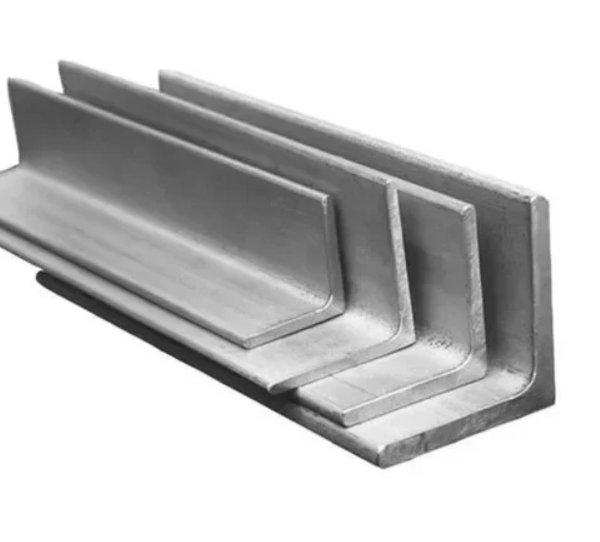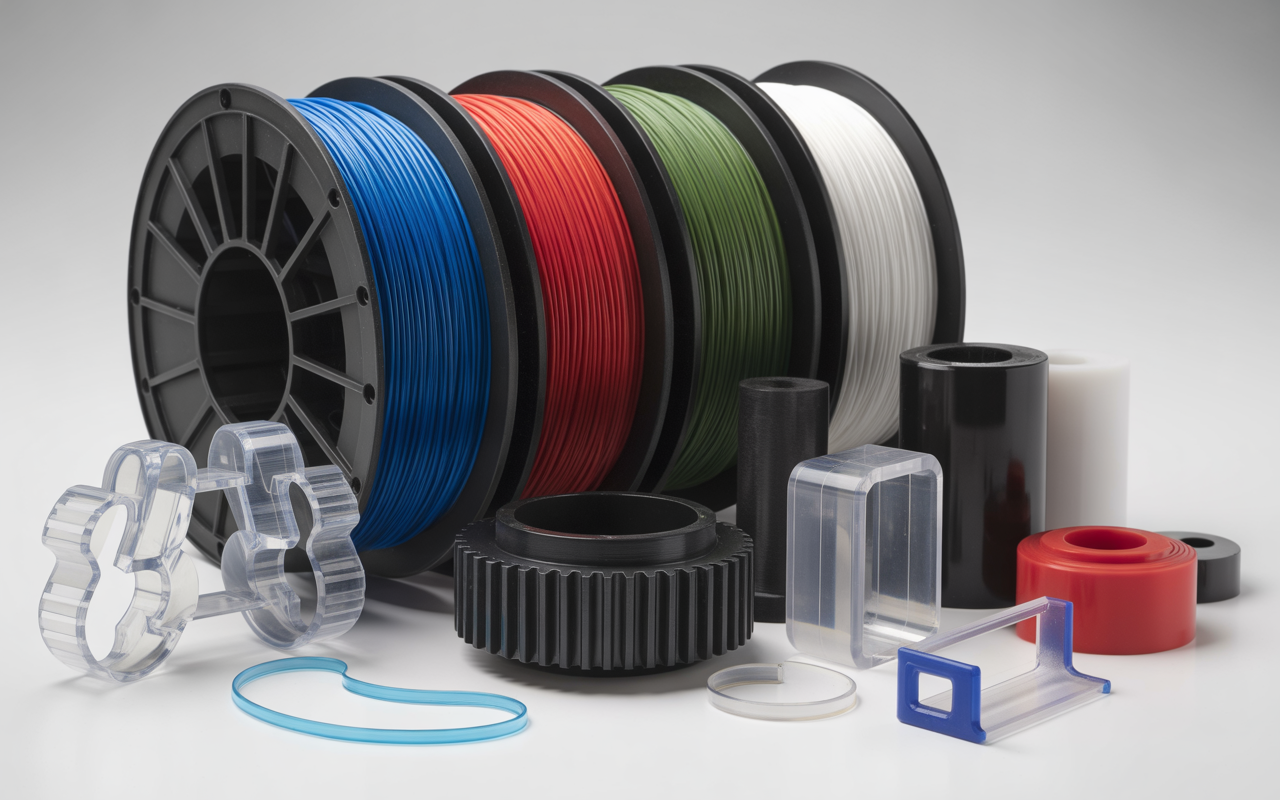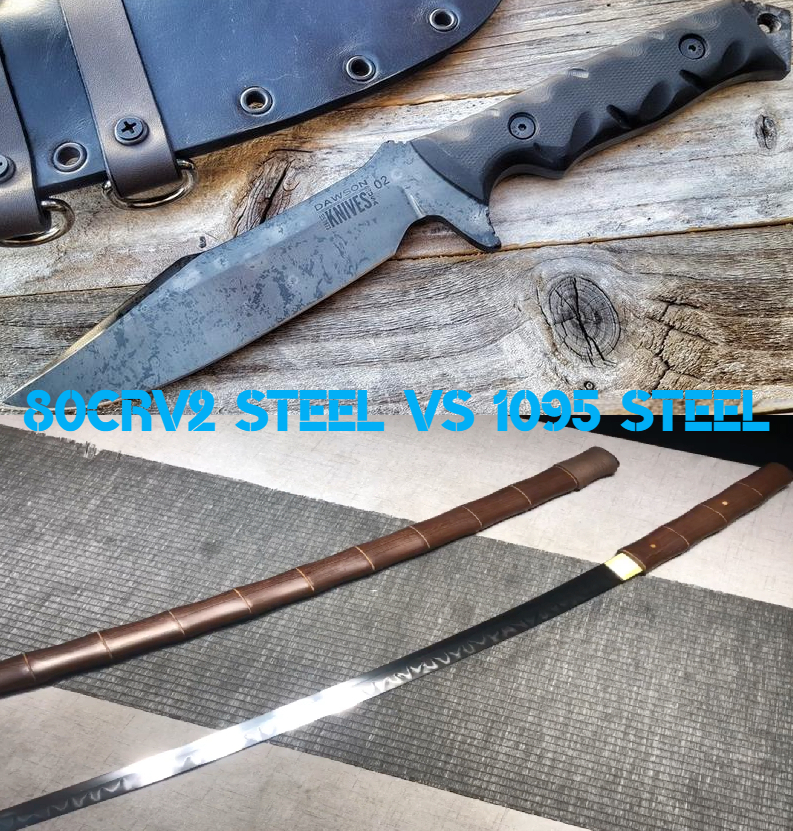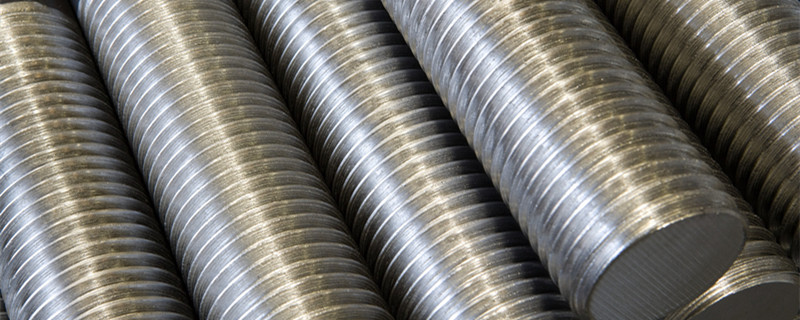Carbon steel, which is characterized by a high carbon content, is very common in various manufacturing processes and industries. Here is everything about the carbon steel material, including its definition, designation, corrosion resistance, types, properties, grades, uses, and comparison with other types of materials like stainless steel, alloy steel, and cast iron.

What Is Carbon Steel?
Carbon steel is a type of alloy primarily composed of iron and carbon, with carbon content ranging from about 0.05% to 2.1%. The American Iron and Steel Institute (AISI) defines carbon steel as a steel that does not require minimum amounts of alloying elements such as chromium, nickel, or molybdenum. Carbon steels typically have manganese up to 1.65%, silicon up to 0.60%, and copper between 0.40% and 0.60%.
What Are the Uses of Carbon Steel?
Carbon steel finds broad applications in construction, automotive manufacturing, machinery, railways, and piping. Its affordability and range of mechanical properties make it a preferred material for structural components, tools, and infrastructure. However, carbon steel requires protective coatings or alloying to resist rust, especially in moist environments.
SAE/AISI Carbon Steel Designation
The carbon steel designation in the AISI/SAE system uses a four-digit code, where the first digit indicates the general type or category of the steel. In this standard, carbon steels are grouped in the 1xxx series, meaning all steels starting with “1” are carbon steels. Because carbon steels have varying properties depending on their specific composition, they are further divided into subclasses based on carbon and other element content. The second digit in the steel designation shows whether major secondary elements are present. The last two digits represent the approximate carbon content in hundredths of a percent. For example, SAE 1018 refers to a plain carbon steel with no major secondary elements and approximately 0.18% carbon content.
Does Carbon Steel Rust?
Yes, carbon steel rusts easily. This is because carbon steel mainly consists of iron and carbon but lacks enough chromium, which is the key to forming a protective oxide layer on the surface. Without this layer, carbon steel is very vulnerable to rust when exposed to moisture, oxygen, or humid environments.
Why Does Carbon Steel Rust?
Carbon steel rusts due to its chemical composition and the environmental conditions it faces. The steel’s primary element is iron, which reacts with oxygen and moisture in the air or water, causing oxidation. This reaction produces iron oxide, commonly known as rust, which appears as a reddish-brown layer on the surface. Once rust forms, it continues to absorb moisture and oxygen, accelerating the corrosion process. Environmental factors such as humidity, salt, acidic conditions, and temperature changes can speed up rust formation by providing moisture and corrosive agents that facilitate oxidation.
Does Carbon Steel Rust in Saltwater?
Yes, carbon steel rusts in saltwater, and in fact, it rusts faster in saltwater than in freshwater. Saltwater is a highly corrosive environment because salt increases the water’s electrical conductivity, which speeds up the oxidation process. When carbon steel is exposed to saltwater, the presence of salt ions accelerates the chemical reactions that produce rust, causing the steel to corrode more rapidly. This is why carbon steel structures or tools used near or in the ocean require additional protective coatings or treatments to resist rust.
Does Carbon Steel Rust Faster Than Stainless Steel?
Yes, carbon steel rusts much faster than stainless steel. Stainless steel contains at least 10.5% chromium, which reacts with oxygen to form a thin, durable, and self-healing chromium oxide layer on its surface. This layer acts as a barrier that protects the steel underneath from rust and corrosion. But carbon steel does not contain the chromium element, so it can’t form such a protective layer.
Carbon Steel Corrosion Resistance & Rate
Carbon steel naturally has limited resistance to corrosion. Corrosion is a chemical or electrochemical reaction where the metal reacts with its environment—such as air, water, or pollutants—causing the metal to deteriorate over time.
The rate at which carbon steel corrodes depends heavily on the environment it is in. In general, corrosion rates for carbon steel can vary widely, from about 20 micrometers per year in clean rural air to over 100 micrometers per year in harsh coastal environments. This means that carbon steel can lose a significant amount of material each year if left unprotected, which can impact its strength and durability.
Carbon Steel Corrosion Resistance Chart
| Chemical / Environment | Carbon Steel Corrosion Resistance |
|---|---|
| Acetate Solvents (Crude) | 2 (Good) |
| Acetic Acid (10-80%) | 0 (Not Recommended) |
| Acetone | 2 (Good) |
| Ammonia (Anhydrous) | 1 (Excellent) |
| Benzene | 2 (Good) |
| Chlorine (Liquid) | 2 (Good) |
| Hydrochloric Acid (20-38%) | 0 (Not Recommended) |
| Nitric Acid (30-100%) | 0 (Not Recommended) |
| Phosphoric Acid (25-85%) | 0 (Not recommended) |
| Sodium Hydroxide (30-70%) | 2-3 (Good to Fair) |
| Sodium Chloride (30%) | 2 (Good) |
| Sulfuric Acid (100%) | 2 (Good) |
| Water (Distilled) | 0 (Not Recommended) |
| Water (Sea) | 0 (Not Recommended) |
| Alcohols (various) | 2 (Good) |
| Oils (Mineral, Vegetable, etc.) | 2-3 (Good to Fair) |
Carbon Steel Properties Table
Take a quick look at the properties of low, medium, and high-carbon steels from this chart, including hardness, strength, elongation, and more.
| Properties | Low Carbon | Medium Carbon | High Carbon |
|---|---|---|---|
| Modulus of Elasticity (GPa) | 186 | 200 | 205 |
| Brinell Hardness | 121 | 201 | 293 |
| Yield Strength (MPa) | 350 | 415 | 570 |
| Ultimate Tensile Strength (MPa) | 420 | 620 | 965 |
| Elongation at Break (%) | 15 | 25 | 9 |
| Shear Modulus (GPa) | 72 | 80 | 80 |
Classification of Carbon Steel – Types of Carbon Steel
Classification of Carbon Steel by Carbon Content
Carbon steel is primarily classified based on the amount of carbon it contains. Carbon content affects material strength, ductility, hardness, and wear resistance. There are three main types based on carbon percentage.
1. Low-Carbon Steel (about 0.05% and 0.2% Carbon)
Low-carbon steel contains very little carbon, making it softer and more flexible. Because of its low carbon, it is easy to shape, weld, and machine. This type is widely used because it is cheaper to produce and can be formed into many shapes without breaking.
- Uses: Structural shapes, automotive body panels, pipes, and wire.
- Properties: Good ductility (flexible, can be bent without breaking), lower strength and hardness compared to other carbon steels.
2. Medium-Carbon Steel (about 0.2% and 0.5% Carbon)
Medium-carbon steel has a moderate amount of carbon, giving it a good balance between strength and ductility. It is stronger and harder than low-carbon steel but still retains decent flexibility.
- Uses: Machine parts, automotive components, gears, shafts, and forgings.
- Properties: Good wear resistance and strength, suitable for parts that need to withstand mechanical stress.
3. High-Carbon Steel (over 0.5% Carbon)
High-carbon steel contains higher carbon content, so this category of steel is very hard and strong but less ductile. It is resistant to wear and abrasion, meaning it lasts longer when used in applications involving friction or cutting.
- Uses: Springs, cutting tools (knives, blades), high-strength wires.
- Properties: High hardness and strength, less flexible, and more brittle compared to lower carbon steels.
Classification of Carbon Steel by AISI/SAE Designation System
The AISI/SAE system uses a four-digit code to classify steels. All carbon steels fall in the 1xxx series, here are common subclasses.
1. 10xx Series: Plain Carbon Steels
These steels have a maximum of 1.00% manganese and no added sulfur or phosphorus. They are basic carbon steels with standard properties.
- Use: General-purpose steels, structural and mechanical parts.
- Example: SAE 1020 (around 0.20% carbon).
2. 11xx Series: Resulfurized Carbon Steels
These steels have added sulfur to improve machinability — meaning they are easier to cut, drill, or machine.
- Use: Components that require extensive machining.
- Tradeoff: Slightly reduced ductility and toughness due to sulfur.
3. 12xx Series: Resulfurized and Rephosphorized Carbon Steels
These contain both sulfur and phosphorus, further enhancing machinability and surface finish but can reduce toughness.
- Use: High-speed machining parts requiring good surface quality.
Properties: Excellent machinability, but less ductile.
4. 15xx Series: High-Manganese Carbon Steels (Non-Resulfurized)
These steels have no added sulfur but use higher manganese content (up to 1.65%) to improve machinability without the negative effects of sulfur.
- Use: Parts needing good wear resistance and machinability without sulfur drawbacks.
- Properties: Balanced machinability and toughness.
Classification Based on Deoxidation Process
Carbon steel is also classified by how it is deoxidized during production, which affects its internal structure and quality:
- Rimmed Steel: Only partially deoxidized, with an outer rim of pure iron and an inner core with impurities. Used for deep drawing and forming.
- Capped Steel: Partially deoxidized with a “cap” to reduce surface defects.
- Killed Steel: Fully deoxidized, resulting in uniform composition and good mechanical properties. Preferred for critical applications.
- Semikilled Steel: Partially deoxidized, a compromise between rimmed and killed steel.
Common Grades of Carbon Steels and Uses
1. AISI 12L14 Carbon Steel
AISI 12L14 is known as a free-machining carbon steel containing lead. It typically contains about 0.15% carbon and is widely used for parts requiring extensive machining. Its outstanding machinability rating (160% relative to standard 1212 steel) makes it ideal for mass production of precision components with good tensile and yield strength.
2. AISI 1018 Carbon Steel
AISI 1018 is a low-carbon steel known for its good formability, weldability, and moderate strength. With a carbon content around 0.15–0.20%, it is widely used for structural and mechanical applications where moderate strength and good machinability are required. It is commonly employed in the manufacture of shafts, pins, and spindles.
3. AISI 1070 Carbon Steel
AISI 1070 is a high-carbon steel with approximately 0.65–0.75% carbon content, offering higher tensile strength and hardness compared to lower-carbon steels. It is suitable for applications requiring greater wear resistance and strength, such as springs and cutting tools, but it is less ductile and more difficult to machine.
4. AISI 1045 Carbon Steel
AISI 1045 is a medium carbon steel with good strength, toughness, and wear resistance. It has excellent weldability and machinability in its normalized or hot-rolled state. With carbon content around 0.42–0.50%, it is often used in industrial applications such as gears, shafts, and axles where higher strength and impact resistance are critical.
5. ASTM A36 Steel
ASTM A36 is a widely used mild structural steel known for its excellent weldability and machinability. It contains approximately 0.25% carbon and is commonly produced in hot-rolled form. Its relatively low tensile and yield strengths make it ideal for structural applications like bridges, buildings, and heavy equipment.
6. AISI 1095 Carbon Steel
AISI 1095 is a high-carbon steel with a carbon content of 0.9–1.03%, resulting in high hardness and strength but increased brittleness. It is commonly used for cutting tools, springs, and applications requiring sharp edges. It offers good wear resistance but lower machinability and weldability compared to lower carbon steels.
7. AISI 1008 Carbon Steel
AISI 1008 is a very low-carbon steel with about 0.10% carbon content, known for excellent weldability and formability. It is often used in cold-headed or cold-formed components where ductility and ease of fabrication are more critical than strength. It has moderate machinability and is used in applications requiring a good surface finish.
8. AISI 1215 Carbon Steel
AISI 1215 is a free machining carbon steel with around 0.09% carbon and added sulfur for improved machinability. It has mechanical properties similar to 12L14 but with slightly different sulfur and manganese content. Its machinability rating is high, making it suitable for parts requiring extensive machining, such as fasteners and fittings.
9. AISI 1020 Carbon Steel
AISI 1020 is a low-carbon steel with 0.17–0.23% carbon, offering good weldability, machinability, and moderate strength. It is commonly used in turned, cold-drawn, or polished conditions and is suitable for parts such as shafts, camshafts, and gears. While it does not harden well through induction or flame hardening, carburizing is possible for surface hardening.
High/Medium/Low Carbon Steel Grade Chart
| Grade | Carbon % | Mn % | Sulfur % | Tensile Strength (MPa) | Yield Strength (MPa) | Elongation (%) | Hardness (Brinell) | Machinability (Relative to AISI 1212=100) | Density (g/cm³) | Typical Applications |
|---|---|---|---|---|---|---|---|---|---|---|
| 12L14 | 0.15 | 0.85–1.15 | 0.26–0.35 | 540 | 415 | 10 | 163 | 160 | 7.87 | High machining parts, precision components |
| 1018 | 0.15–0.20 | 0.60–0.90 | ≤0.05 | 440 | 370 | 15 | 126 | 70 | 7.87 | Shafts, pins, spindles |
| 1070 | 0.65–0.75 | 0.60–0.90 | ≤0.05 | ~690 (approximate) | – | – | – | – | ~7.7–8.03 | Springs, cutting tools |
| 1045 | 0.42–0.50 | 0.60–0.90 | ≤0.05 | 565 | 310 | 16 | 163 | – | 7.87 | Gears, shafts, axles |
| ASTM A36 | 0.25–0.29 | ~1.03 | ≤0.05 | 400–550 | 250 | 20–23 | – | 72 | 7.85 | Structural steel, bridges, buildings |
| 1095 | 0.90–1.03 | 0.30–0.50 | ≤0.05 | 685 | 525 | 10 | 197 | 45 | 7.85 | Cutting tools, springs |
| 1008 | 0.10 | 0.30–0.50 | 0.05 | 340 | 285 | 20 | 95 | 55 | 7.87 | Cold-formed parts, weldable components |
| 1215 | 0.09 | 0.75–1.05 | 0.26–0.35 | 540 | 415 | 10 | 167 | 140 | 7.87 | High machinability parts, fasteners |
| 1020 | 0.17–0.23 | 0.30–0.60 | ≤0.05 | 395 | 295 | 36.5 | 111 | High (exact % not specified) | 7.87 | Shafts, camshafts, gears, structural parts |
Carbon Steel vs Stainless Steel – Difference Between Stainless Steel and Carbon Steel
The basic elements of steel are iron and carbon. Steels with a higher carbon content are harder and more brittle; on the contrary, steels with a lower carbon content are more ductile and tough. Stainless steel is a type of steel that contains iron, carbon, and at least 10.5% chromium content. The protective layer of chromium sets a barrier between the iron in the metal and the water in the environment. There are some differences between carbon steel and stainless steel, but one is not necessarily better than the other. Every material has its pros and cons. The key is to make the steel match the work requirements. Stainless steel machining services at Junying can offer you the most cost-effective solution for your production needs.
| Difference | Carbon Steel | Stainless Steel |
|---|---|---|
|
Composition |
Iron + 0.2–2.1% Carbon; minimal other alloys | Iron + ≥10.5% Chromium + Nickel, Molybdenum, etc. |
| Corrosion Resistance | Poor, rusts easily without coating | Excellent, chromium oxide layer prevents rust |
| Strength | Generally stronger and harder | Strong, but usually less hard than carbon steel |
| Ductility | Lower ductility decreases with more carbon | Higher ductility due to nickel, except for martensitic |
| Appearance | Dulls, rusts, less attractive | Shiny, maintains luster without rusting |
| Melting Point | ~1410–1540°C (varies with carbon content) | ~1375–1530°C |
| Density | ~7850 kg/m³ | ~8000 kg/m³ |
| Thermal Expansion | (10.8–12.5)×10⁻⁶ m/m°C | (10–17.3)×10⁻⁶ m/m°C |
| Thermal Conductivity | Higher | Lower |
| Price | Lower cost | Higher cost |
| Maintenance | Requires frequent protection against corrosion | Low maintenance, easy to clean |
| Workability | Easier to cut, forge, and weld | Harder to work with, higher fabrication cost |
| Applications | Structural, tools, automotive parts, machinery | Medical, food processing, architecture, appliances |
| Weight | Lighter | Heavier |
Stainless steel and carbon steel, which one to choose?
Choose carbon steel if your project demands high hardness and strength at a lower cost, especially for applications like tools or structural parts where appearance and corrosion resistance are not critical or can be managed with coatings. It’s also the better choice if weight is a concern or if you need easier fabrication, such as cutting, forging, and welding. Carbon steel works well in dry or indoor environments where exposure to moisture and corrosive elements is limited.
Opt for stainless steel when corrosion resistance and low maintenance are top priorities, such as in outdoor, humid, or chemically aggressive environments. It’s ideal if you want a polished, attractive finish and are willing to invest more for durability and longevity. Stainless steel offers better toughness and ductility, though it is heavier and more challenging to work with, making it suitable for applications where aesthetics, hygiene, and resistance to staining are important.
Carbon Steel vs Cast Iron – Difference Between Cast Iron and Carbon Steel
Carbon steel and cast iron are both popular materials for cookware, such as pans. To determine which one to choose for specific applications, let’s see their differences first.
On the whole, carbon steel is stronger, tougher, more ductile, weldable, and easier to form, making it ideal for structural, automotive, and tool applications. It heats up and cools down quickly, is lighter, and offers better temperature control in cooking. Cast iron is harder, more brittle, excellent for casting complex shapes, wear-resistant, and has better vibration damping. It retains heat longer, is heavier, and is preferred for cookware that benefits from steady heat and durability.
| Difference | Carbon Steel | Cast Iron |
|---|---|---|
| Chemical Composition | 0.05–2.0% Carbon, 0.15–0.35% Si, 0.30–1.5% Mn, ≤0.05% S, ≤0.04% P, alloy elements like Cr, Ni, Mo possible | 2.0–4.0% Carbon, 1.0–3.0% Si, 0.2–1.0% Mn, ≤0.10% S, ≤0.15% P, rarely alloyed (except ductile iron) |
| Density | 7.85 g/cm³ (0.284 lb/in³) | 7.1–7.3 g/cm³ (0.257–0.264 lb/in³) |
| Hardness (Annealed) | 120–250 HB | 150–300 HB (gray iron) |
| Thermal Conductivity | 45–65 W/m·K (31.1–45.1 BTU/hr·ft·°F) | 25–55 W/m·K (17.3–37.8 BTU/hr·ft·°F) |
| Melting Point | 1,425–1,535°C (2,597–2,795°F) | 1,150–1,260°C (2,102–2,300°F) |
| Tensile Strength | 370–1,500 MPa (53.6–217.6 ksi) | 150–400 MPa (21.8–58.0 ksi) |
| Yield Strength | 230–1,000 MPa (33.4–145 ksi) | 100–250 MPa (14.5–36.3 ksi) |
| Ductility (Elongation) | 15–25% | <1% |
| Impact Toughness | High (50–200 J / 37–148 ft-lb) | Low (5–20 J / 3.7–14.8 ft-lb for gray iron) |
| Fatigue Strength | 200–600 MPa (29–87 ksi) | 70–200 MPa (10.1–29 ksi) |
| Compressive Strength | 250–1,500 MPa (36.3–217.6 ksi) | 500–1,200 MPa (72.5–174 ksi) |
| Wear Resistance | Moderate | Excellent |
| Vibration Damping | Moderate | Excellent |
| Corrosion Resistance | Poor without coating; rusts easily | Better due to high C and Si, but gray iron can rust |
| Machinability | Variable: low-carbon is gummy; high-carbon is hard on tools | Good due to graphite flakes acting as lubricants |
| Weldability | Excellent (especially low-carbon steel) | Poor; requires preheating and special electrodes |
| Formability | Good for forging, rolling, extrusion | Brittle, non-malleable, not forgeable |
| Heat Treatment | Highly responsive (can tailor hardness/toughness) | Limited (mainly stress-relief annealing) |
| Weight | Lighter | Heavier |
| Heat Retention | Heats and cools quickly | Holds heat longer |
| Cooking Control | Better temperature control (responsive heating) | Slower response, steady temperature |
| Surface Finish | Smooth (stamped from sheets) | Rougher (cast in molds) |
| Cost | Generally higher upfront cost | Generally lower upfront cost |
| Applications | Structural beams, automotive parts, tools, pipelines | Engine blocks, brake discs, cookware, hydraulic manifolds |
Carbon Steel vs Alloy Steel – Difference Between Alloy Steel and Carbon Steel
Carbon steel is favored for its cost-effectiveness and ease of welding, especially in construction and general manufacturing. Alloy steel is chosen when performance under harsh conditions (wear, corrosion, heat) is critical, such as in aerospace, automotive, and chemical industries. For some properties, like hardness and machinability, it’s difficult to give a definite comparison for all steels, as they vary greatly between different grades.
| Difference | Carbon Steel | Alloy Steel |
|---|---|---|
| Composition | Primarily iron + carbon (up to 2%) | Iron + carbon + other alloying elements (Si, Cr, Mo, Ni, V, Co, W, Al, etc.) |
| Carbon Content | Low: <0.3%, Medium: 0.31–0.60%, High: 0.61–1.5%, Ultra-high: up to 2% | Varies; low-alloy (1–5% alloying elements), high-alloy (>5%, e.g., stainless steel with ~12% Cr) |
| Strength | High (up to ~965 MPa for high carbon) | Higher tensile strength (up to 1882 MPa), depending on alloy |
| Toughness | High | Generally lower than carbon steel but can be improved by alloy selection |
| Ductility | Lower (decreases with carbon) | Higher due to alloying elements that improve ductility |
| Corrosion Resistance | Poor (unless coated) | Good to excellent, depending on alloying elements |
| Wear Resistance | Moderate to high (especially high carbon steel) | High due to alloying elements like cobalt, chromium, and vanadium |
| Heat Resistance | Fair | High, especially with elements like molybdenum and tungsten |
| Thermal Conductivity | High (~45 W/mK) | Moderate (40–60 W/mK) but generally lower than carbon steel |
| Weldability | High (especially low carbon) | Lower, welding is more complex due to alloying elements |
| Machinability | Good to excellent (especially low carbon) | Fair to good, depends on alloying elements |
| Magnetism | Magnetic (varies with carbon content) | Usually magnetic, but may vary by alloy type |
| Melting Point | 1425–1530°C | 1400–1500°C, varies by alloying elements |
| Heat Treatability | Yes | Yes |
| Cost | Lower, varies with carbon content | Higher, due to alloying elements and complex processing |
| Applications | Construction, shipbuilding, pipes, pressure vessels, automotive body parts, machinery parts, tools, springs, dies, bridges | Structural components, automotive parts, aerospace, mining, machinery, rails, bolts, gears, chemical and power plants |







